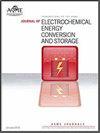乙醇火焰法制备的螺旋碳纳米纤维作为锂离子电池正极材料的电化学评价
IF 1.9
4区 工程技术
Q3 ELECTROCHEMISTRY
Journal of Electrochemical Energy Conversion and Storage
Pub Date : 2022-07-21
DOI:10.1115/1.4055042
引用次数: 0
摘要
目前,大多数锂离子电池负极材料由于体积膨胀和极化而存在容量退化和循环寿命降低的问题。本文采用简单的乙醇火焰法制备了螺旋碳纳米纤维(HCNFs),并测试了其作为锂离子电池负极材料的电化学性能。结果表明,HCNFs具有较高的可逆容量(在50 mA·g−1电流密度下比容量为622.9 mAh·g−1)、良好的倍率性能和优良的循环稳定性(在200 mA·g−1电流密度下循环100次后比容量为395.6 mAh·g−1,库仑效率超过98%,容量保持率为94.41%)。HCNFs具有独特的螺旋结构,为lib中的插/脱插提供了强大的支撑空间,有效缓解了负极材料的体积膨胀和极化。此外,HCNFs还具有优异的导电性和化学稳定性。HCNFs制备工艺简单,性能优越,是锂离子电池极具潜力的负极材料。本文章由计算机程序翻译,如有差异,请以英文原文为准。
Electrochemical evaluation of helical carbon nanofibers prepared by ethanol flame method as anode materials of lithium-ion batteries
Currently, most of anode materials for lithium-ion batteries (LIBs) suffer from the problems of capacity degradation and reduction of cycle life due to the volume expansion and polarisation. Here we have successfully prepared helical carbon nanofibers (HCNFs) by a simple ethanol flame method (EFM) and tested their electrochemical performance as anode materials for LIBs. The results show that HCNFs possess high reversible capacity (specific capacity of 622.9 mAh·g−1 at a current density of 50 mA·g−1), good rate performance and excellent cycling stability (specific capacity of 395.6 mAh·g−1 after 100 cycles at a current density of 200 mA·g−1, coulombic efficiency of over 98 % and capacity retention of 94.41 %). HCNFs possess unique helical structure, which provide a strong support space for the intercalation/deintercalation in LIBs, and effectively alleviate the volume expansion and polarisation of the anode material. What's more, HCNFs exhibit excellent electrical conductivity and chemical stability. The facile preparation route and superior properties of HCNFs make it potential anode materials for LIBs.
求助全文
通过发布文献求助,成功后即可免费获取论文全文。
去求助
来源期刊

Journal of Electrochemical Energy Conversion and Storage
Engineering-Mechanics of Materials
CiteScore
4.90
自引率
4.00%
发文量
69
期刊介绍:
The Journal of Electrochemical Energy Conversion and Storage focuses on processes, components, devices and systems that store and convert electrical and chemical energy. This journal publishes peer-reviewed archival scholarly articles, research papers, technical briefs, review articles, perspective articles, and special volumes. Specific areas of interest include electrochemical engineering, electrocatalysis, novel materials, analysis and design of components, devices, and systems, balance of plant, novel numerical and analytical simulations, advanced materials characterization, innovative material synthesis and manufacturing methods, thermal management, reliability, durability, and damage tolerance.
 求助内容:
求助内容: 应助结果提醒方式:
应助结果提醒方式:


